Leamington Football Club - taking the brakes off
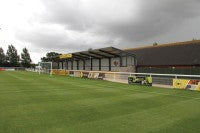 Royal Leamington Spa sits smack bang in the centre of the county of Warwickshire. As its name implies, its popularity grew out of the spa water that could be taken and, although the pump room still exists, this is now a library and museum. Spa water may still be sampled outside the building though.
Royal Leamington Spa sits smack bang in the centre of the county of Warwickshire. As its name implies, its popularity grew out of the spa water that could be taken and, although the pump room still exists, this is now a library and museum. Spa water may still be sampled outside the building though.
The 'Royal' prefix is now rarely used, and the town is generally referred to as Leamington Spa or simply Leamington. It became best known as the home of two companies allied to the motor trade - Lockheed, who made brakes, and Borg & Beck, manufacturers of clutches.
The town's football club have previously been known as Lockheed Leamington and AP Leamington, the AP denoting Automotive Products when Lockheed and Borg & Beck merged. They are now known as Leamington FC.
The club was formed in 1891 and, for many years, played at the town's Windmill ground. Typical of many lower league teams, it has had a checkered history. In 1937, the Windmill ground was sold to Coventry City, who used it as a base for their A team. Birmingham City even used the ground for five 'home' games in the 1939-40 season, whilst an exiled Czech army, based in Leamington during the war, played two international matches against Belgium and Norway in 1941.
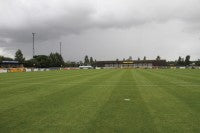 The club was reformed in 1944 and enjoyed much local success, culminating in winning the Southern League Premier Division title in 1983. However, promotion was denied as the Windmill Ground was deemed not to be up to Alliance Premier League standard. Kidderminster Harriers were promoted in their place and they have hardly looked back since. The Brakes, as Leamington are fondly known, also reached the FA Cup second round twice during this period.
The club was reformed in 1944 and enjoyed much local success, culminating in winning the Southern League Premier Division title in 1983. However, promotion was denied as the Windmill Ground was deemed not to be up to Alliance Premier League standard. Kidderminster Harriers were promoted in their place and they have hardly looked back since. The Brakes, as Leamington are fondly known, also reached the FA Cup second round twice during this period.
However, with the AP company in decline, the club became just Leamington FC in 1985. Relegation from the Southern League Midland Division came in 1987 as things went badly awry. They resigned from the Midland Combination at the end of the 1987-88 season, having lost the Windmill Ground to developers; the old stadium is now a housing estate, whilst the AP company is a shadow of its former self.
Twelve years of exile followed, but the 'club', held together by a consortium of committed individuals - and having acquired six acres of land from a local farmer in 1991 - set about re-establishing the club.
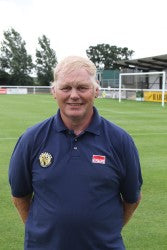 With planning permission approved, the consortium began building a pitch that conformed to FA guidelines. With the local soil being heavy clay, a primary drainage scheme was installed at five metre centres running the length of the pitch, consisting of 100mm diameter pipes at a depth of 375 mm. However, the system was compromised when the gravel infill was covered with 225mm of the original clay soil!
With planning permission approved, the consortium began building a pitch that conformed to FA guidelines. With the local soil being heavy clay, a primary drainage scheme was installed at five metre centres running the length of the pitch, consisting of 100mm diameter pipes at a depth of 375 mm. However, the system was compromised when the gravel infill was covered with 225mm of the original clay soil!
Leamington Football Club finally returned to action in the 2000-01 season in the Midlands Combination Second Division at the New Windmill Ground, but clearly, there were issues with the pitch. So, just prior to their new league campaign, the club called on the highly experienced Idris Elms to become head groundsman.
Over the course of the following ten seasons, Idris has improved the pitch beyond recognition, receiving many awards and accolades along the way.
So, how did he achieve this?
"My first priority was to improve the drainage and develop an ongoing programme of work to improve the playing surface," explains Idris. "In 2001, the pitch was gravel banded, installing secondary drainage - sand slits at two metre centres - to help take surface water away. Also, as part of the end of season work, I reseeded the pitch with four bags of ryegrass and topdressed with 100 tonnes of Severn Estuary sand."
I am intrigued as to why he would use estuary sand?
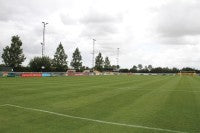 "Beyond its first role of providing a rounded shape that prevents capping and allow faster infiltration of water, I find there are a number of other bonuses from using estuary sand," continues Idris "For example, the pitch does not freeze until approximately minus 5OC, due to the salt content. In addition, the shells contained in the sand break down and release calcium, helping to keep the ph at 6.5-7.5, which is ideal for ryegrass. I also find that fertiliser uptake seems more rapid. Again, this could be because of the salt content aiding the osmotic process. I believe it has also reduced worm activity, as the little blighters don't appear to like salt!"
"Beyond its first role of providing a rounded shape that prevents capping and allow faster infiltration of water, I find there are a number of other bonuses from using estuary sand," continues Idris "For example, the pitch does not freeze until approximately minus 5OC, due to the salt content. In addition, the shells contained in the sand break down and release calcium, helping to keep the ph at 6.5-7.5, which is ideal for ryegrass. I also find that fertiliser uptake seems more rapid. Again, this could be because of the salt content aiding the osmotic process. I believe it has also reduced worm activity, as the little blighters don't appear to like salt!"
In 2001, the club purchased a rake and spiker to tow behind a ride-on mower, and continued to improve the porosity of the pitch by further topdressing with the estuary sand. That same year, the club were promoted from Midland Combination Level 1 to Midland Combination Premier.
In 2003, Idris won the first of many awards, being named the Birmingham County FA Groundsman of the Year for Level 7 and runner-up in Northwest and West Midlands Area Groundsman of the Year.
Further improvements to the ground were made with the installation of floodlights, whilst Idris purchased a set of self travelling sprinklers.
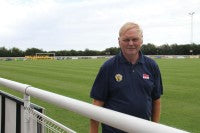 "With so many games being played, compaction of the surface is always going to be a problem," says Idris, "especially on clay soil. So, to help reduce the affects of compaction and also aid drainage, I had the pitch linear-aerated using a Blec Groundbreaker, inserting slits to a depth of 225mm, whilst continuing with the annual renovation programme of topdressing and seeding."
"With so many games being played, compaction of the surface is always going to be a problem," says Idris, "especially on clay soil. So, to help reduce the affects of compaction and also aid drainage, I had the pitch linear-aerated using a Blec Groundbreaker, inserting slits to a depth of 225mm, whilst continuing with the annual renovation programme of topdressing and seeding."
In 2004, Idris took the decision to carry out all the renovation work himself. "Like many lower league clubs, finances are tight, and the expense of employing a contractor was one that I could do away with by undertaking the work myself. It also allowed me to control the work being carried out. So, I hired in the relevant equipment and found the additional time to do the work over and above my contracted twenty hours a week."
Idris also helps out at Kenilworth Croquet Club, Avenue Bowling Club and Kenilworth Wardens Cricket Club, so this was no mean feat.
"I've been very pleased with the performance of the Blec Groundbreaker, and will use it every year from here on in to improve drainage and decompaction," he states.
In 2007, the club were promoted again, this time to the Southern League Midland Division and, by 2008, were able to play a full season without any matches being cancelled due to the hard work and commitment of Idris and his two volunteer assistants. Nigel Hodgkins and George Pirie help out on match days and at other times, as required.
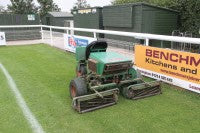 The pitch is cut using an old Ransomes 180 Triple cylinder mower. "On average, I cut three times a week at a height of 32mm. I like to do a final cut and mark out on match days. However, as matches can be played on different days of the week, this is not always possible," explains Idris.
The pitch is cut using an old Ransomes 180 Triple cylinder mower. "On average, I cut three times a week at a height of 32mm. I like to do a final cut and mark out on match days. However, as matches can be played on different days of the week, this is not always possible," explains Idris.
"Being mindful of the damage caused by warm-ups and pre-match drills, we have installed a training area next to the main pitch. It's a bit of additional work for me, but does help to reduce the amount of training carried out on the pitch, so it has been worthwhile."
"With over seventy matches a year, retaining grass cover, especially on heavy clay, is always a challenge. A good number of my contracted hours (around eight) are used up on match days and the day after - double cutting, marking out and setting up goals, plus divoting at half time and after the game are time consuming tasks, but I believe it is important to get the pitch cleaned up and ready for recuperation as soon as possible."
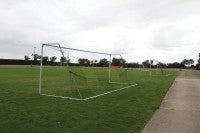 "Due to the clay's high cation capacity, my feeding programmes are tailored to last eight to ten weeks. I use a combination of different granular fertilisers containing a high potash content to aid root recovery, something like a 15:5:20. I also apply a slow release feed down the centre of the pitch to aid recovery in the high wear areas."
"Due to the clay's high cation capacity, my feeding programmes are tailored to last eight to ten weeks. I use a combination of different granular fertilisers containing a high potash content to aid root recovery, something like a 15:5:20. I also apply a slow release feed down the centre of the pitch to aid recovery in the high wear areas."
"A selective weedkiller is applied to control any broad leaf weeds. These are mainly plantains and dandelions that are blown in from the surrounding farmers fields."
In recent years Idris has been oversowing the pitch with Limagrain's MM25 mix which contains 20% Milan, 15% Sanremo and 45% Melbourne perennial ryegrasses, plus 20% Mocassin, a slender creeping red fescue.
"I find this mixture seems to be more hard wearing, and recovers well from damage, with the fescue growing beneath the ryegrasses to provide a cushioning affect and help reduce the incidence of disease."
"By 2009, we were only applying eighty tonnes of sand to the main pitch, but a further thirty tonnes were needed for the training area, so one cancelled out the other, cost wise" explains Idris.
In the same year, the club gained yet another promotion and now play in the Southern Premier League.
"In 2011, the long dry summer created another set of problems to overcome," bemoans Idris. "We simply did not have enough water to efficiently irrigate the clay soils, which began cracking at depth, collapsing a number of the old gravel band drainage runs. These needed refilling and levelling; additional work that was time consuming."
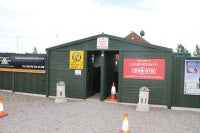 Since moving to their new rural location, the club have been working closely with the Warwickshire Wildlife Trust, aiming to minimise the impact to the local flora and fauna. A number of hedges and trees have been planted to screen off buildings and car parks, and even the clubhouse was designed to resemble a barn so as to blend into the countryside.
Since moving to their new rural location, the club have been working closely with the Warwickshire Wildlife Trust, aiming to minimise the impact to the local flora and fauna. A number of hedges and trees have been planted to screen off buildings and car parks, and even the clubhouse was designed to resemble a barn so as to blend into the countryside.
Native species have been planted to maximise the food source for wildlife. These include hawthorn, blackthorn, cherry, dog rose, hazel and holly. All pruning is done outside the nesting season and once all berries have been consumed.
A local tree surgeon provides chipped waste which is used as mulch around the hedges and to provide a clean carpet for supporters to stand on once off the hardstanding. A side benefit from the mulch is an increased insect population as it degrades which, in turn, provides a further useful supply of food for the wildlife.
All exterior buildings, floodlights and fencing are painted green to blend in with the background and lessen the environmental impact. Even the Severn Estuary sand is a renewable resource.
The club has, both on and off the field of play, achieved a lot in the twelve years since they began life again at the New Windmill Ground, and the work carried out by Idris has been instrumental in their success, providing what is widely regarded as one of the best playing surfaces in the league.
However, Idris is never content. "There is always room for improvement," he says. "I believe we should invest in better equipment. Perhaps a new mower, an automated pop up watering system, and maybe the chance to employ a full-time groundsman or an apprentice that I can train up?"
The club has been a willing partner in ensuring the pitch and club facilities are as good, if not better, than any of their rivals, and this investment has been rewarded by attracting and retaining players to ensure they can continue to compete in a very competitive football league. In the long term, they want to progress further up the football league structure, and all the building blocks are in place to allow that to happen.
The Windmill
The ground began its life known simply as the 'Tachbrook Road Ground' with the first 'Leamington FC' match taking place in late September, 1891, between Leamington Association Football Club and Queen's College, Birmingham.
By 1913, when Leamington Town moved back to the ground (after using various sites around the town), it had been renamed as The Windmill Ground, the name reflecting the fact that there was a derelict windmill (which was demolished in 1968) adjacent to the site.
In 1937, Leamington Town fell foul to money matters, the club was voluntarily wound up, and the Windmill Ground was sold to Coventry City. Coventry paid £1,739/6s/8d for the ground which was to be used for their 'A' team. During the 2nd World War the ground also hosted Forces matches and Birmingham City matches.
Lockheed, the company situated opposite the Windmill Ground, formed a club in 1946 called Lockheed Leamington and bought the ground back from Coventry City to house their team.
It was after this time that the ground saw most of its development work - stands, terracing, etc. The stated capacity of the ground was 5,000 - with cover for 1,600 spectators.
A First Round FA Cup tie, vs Stafford Rangers in the 1975-76 season, saw the largest attendance at the ground. 3,200 turned up to see Stafford triumph 3-2.
With the ground's owners, Automotive Products, struggling financially, property developers AC Lloyd purchased the ground in 1985. The downfall of the club could be said to have started two years previously. Despite winning the Southern League championship in 1983, the club was denied promotion to the Football Conference due to the condition of the ground. Kidderminster Harriers were promoted instead, and a sad downward spiral was put in motion.
The final league match at the ground was on 16 April 1988 against Walsall Wood.
